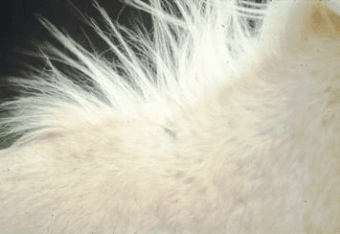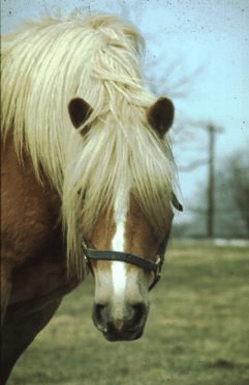What is sweet itch?

Sweet Itch is a skin disease (sometimes called summer itch or seasonal allergic dermatitis) and is caused by an allergy to the saliva of certain biting flies or midges (e.g. Culicoides spp.). It is characterised by intense itching and affected animals may spend hours rubbing against trees, fences, doors or anything else available. This results in damage to the skin and hair especially down the upper neck, back and tail base (dock). In severe cases the entire mane and forelock may be rubbed out and the skin over the ears, neck, withers and tail becomes thickened, dry, rough and hairless. The condition occurs during the warmer months as this is when the flies breed and are active.
How and when does it occur?
Not all horses which are bitten by midges develop sweet itch and a genetic predisposition is suspected. Affected horses have a true hypersensitivity to the saliva of these biting insects. Signs can occur from a very young age and usually become more severe each year.
Signs are seen during the warmer months when the flies are active. These tend to feed in the early morning and late afternoon and can often be seen on the horse’s belly and neck.
Management options for Insect control
 It is important to remember that as this is an allergic condition, symptoms can be triggered by the bites of only a very small number of midges. Culicoides tend to feed at dusk and dawn, so stable horses during these peak feeding periods. Affected horses should be stabled between 4 pm and 7 am. The stables can be made insect-proof by using screens and insect repellent strips. Place fans in stalls to deter the poor flying gnats.
It is important to remember that as this is an allergic condition, symptoms can be triggered by the bites of only a very small number of midges. Culicoides tend to feed at dusk and dawn, so stable horses during these peak feeding periods. Affected horses should be stabled between 4 pm and 7 am. The stables can be made insect-proof by using screens and insect repellent strips. Place fans in stalls to deter the poor flying gnats.
Hoods and rugs reduce the body area exposed to biting but these may be badly damaged by rubbing until the condition is under control.
Fly repellent or insecticidal sprays or creams should be used especially on the mane, tail, withers and head but also along the midline and neck. Insect repellent tags such as those used on cattle can also be attached to the horse’s head collar.
These measures are not effective in all horses. The environment can be important. Culicoides require free standing water to propagate, if possible, affected horses should be moved away from areas where there is mud, wet sand, ponds, streams or rivers nearby.
Topically applied creams and lotions containing antihistamines or corticosteroids can be useful but become very expensive for continual use. Corticosteroids can be given by injection and long acting forms can give relief for several weeks in some cases. It is important to realise that corticosteroid treatment does not cure the condition but merely relieves the itching and that it can have serious side effects such as inducing laminitis and increased risk of infection. Nevertheless, in some cases, there is no alternative but to take these risks in order to relieve severe persistent distress and discomfort.
Most horses can be managed through insect control and topical creams, however not in all cases. It is a very painful and distressing condition which may cause the horse to rub and cause self harm. Call us at CEH to discuss medical options and in severe cases medications such as Steroids, DMSO and antihistamines are needed.
This client information sheet is based on material written by Deidre M Carson BVSc, MRCVS and Sidney W. Ricketts LVO, BSc, BVSc, DESM, DipECEIM, FRCVS. © Copyright 2003 Lifelearn Inc. Used with permission under license. November 27, 2016.
